It’s safe to say that online advertising is a must for any business.
We’re living in a digital age and, if you’re going to stand any chance of selling your products or services, you’re going to need to make sure your ads are landing right in front of your target demographic.
But simply paying for ads in the right places isn’t going to cut it. Forbes has found that the average American is exposed to between 4,000 and 10,000 ads every day.
When you take these statistics into account, it’s not surprising that 27% of Americans are using ad blockers.
Those who don’t block ads have their own mental filters that help them to decide what they want to look at and what they’re going to ignore.
No matter what products or services you’re selling, one thing is growing increasingly clear: You’re going to need some pretty engaging copy to help yours stand out from this ever-growing crowd.
Of course, what’s engaging and what isn’t is a pretty subjective matter. You’re going to want to know what actually works and what doesn’t. This is where ad copy tests can come to the rescue.
To help you create the best ads possible and improve your PPC performance, here are some ground rules, tips, and tricks for your upcoming ad copy tests.
Don’t Test For Testing’s Sake
As a starting point, it is essential to have a hypothesis of what you think will enhance your conversion rate and why – at all times.
Here’s the testing methodology my company follows:
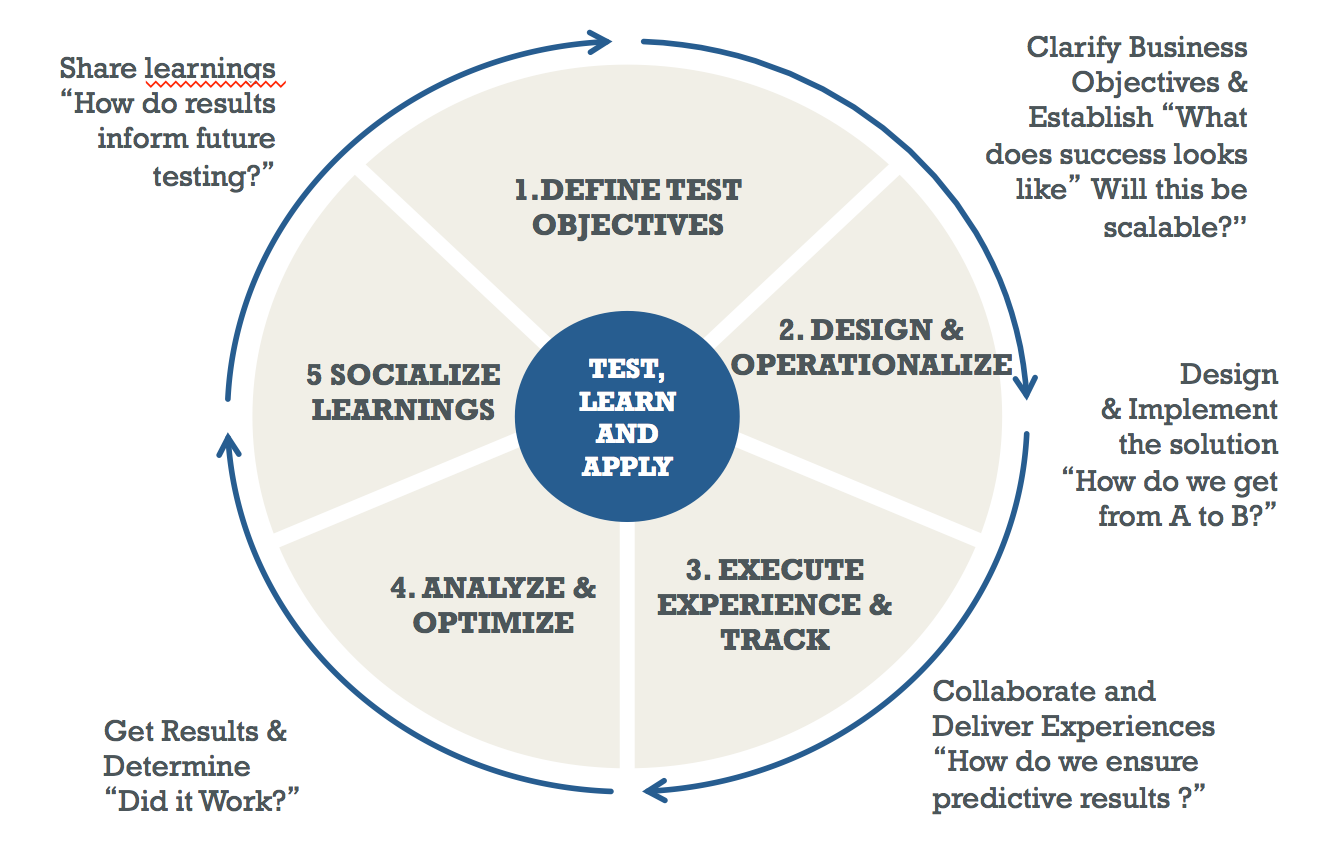 Screenshot by author, April 2022
Screenshot by author, April 2022Aim For Producing Clear Results
Always have ample data when you’re running tests!
Statistical significance should be your goal (in addition to that increased performance).
According to Google, your test should run until it meets one of two conditions:
- At least one variant has a 95% probability to beat baseline (this free A/B calculator should help).
- Two weeks have passed, to account for cyclical variations in web traffic during the week.
This leads us to the last testing ground rule.
Set A Testing Timeframe
Remember that tests shouldn’t be left running forever. Define a specific time frame to gain valuable data and stick to it.
Not every test will result in significance one way or the other and that’s ok. Chalk that test up as inconclusive and move on.
Now, with those ground rules out of the way, onto the tests!
1. Numerical Abbreviations Vs. Full Numerical Values
It’s no secret that ads with numbers help quantify information, whether it’s your inventory, a discount, or the price of your products.
Using numbers makes your ads more attention-grabbing and helps them cut through all the noise that other PPC ads are creating (more about that here).
Numbers also show that you’re a brand worth taking seriously – after all, you have data to back up your claims, right?
So basically, numbers are good.
The question then becomes:
- What do you think your targets will respond to?
- Would it be numerical abbreviations, for example, 15M, or full numerical values, for example, 15,000,000?
When creating an ad copy, it turns out that manipulation of numerical values is a great method of grabbing attention and differentiating ads.
2. Add, Modify, And Remove Pricing
Prices can be a double-edged sword when it comes to PPC ads.
In fact, a recent analysis of top-performing ads shows just 40% of top-performing branded ads and 37% of non-branded ads included numbers.
What?
On one hand, being upfront with your pricing gives users the information they need to know and can subsequently help them make a faster purchase decision.
On the other hand, the price can turn people off by reminding them that they need to spend money. This is especially true if your product and/or service isn’t the cheapest that’s showing up in the search engine results.
So how do you know which approach works? Testing.
We worked with a homebuilder client to test variations of price inclusion. After setting up a few tests, it became clear that by generalizing the number, we could increase CTRs across these communities.
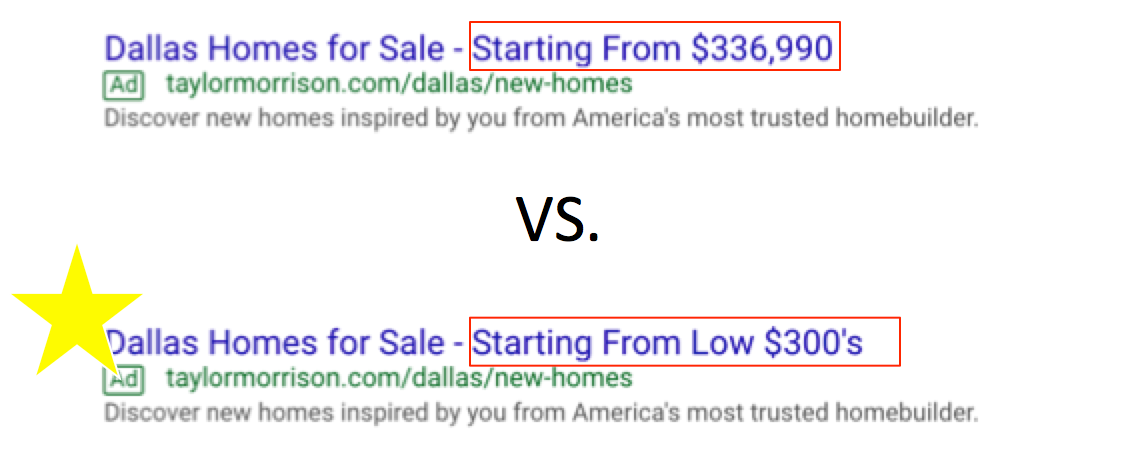 Screenshot by author, August 2017
Screenshot by author, August 2017You can also frame your price as a discount to make it more attractive to readers. And speaking of discounts…
3. Experiment When Quantifying Promotions
In PPC marketing, it’s a common practice to quantify promotions with numbers, usually in the form of discounts, conditional pricing, and other special offers.
For example, instead of writing you have “cheap car accessories on sale,” you can write something more compelling, like “50% off on car accessories.”
But you can maximize your CTRs even further by changing the language you use in your promotions, as well as testing ads that feature percentages, actual pricing, and fully written offers.
Better yet, try testing your ‘discount’ with the top numbers that drive engagement:
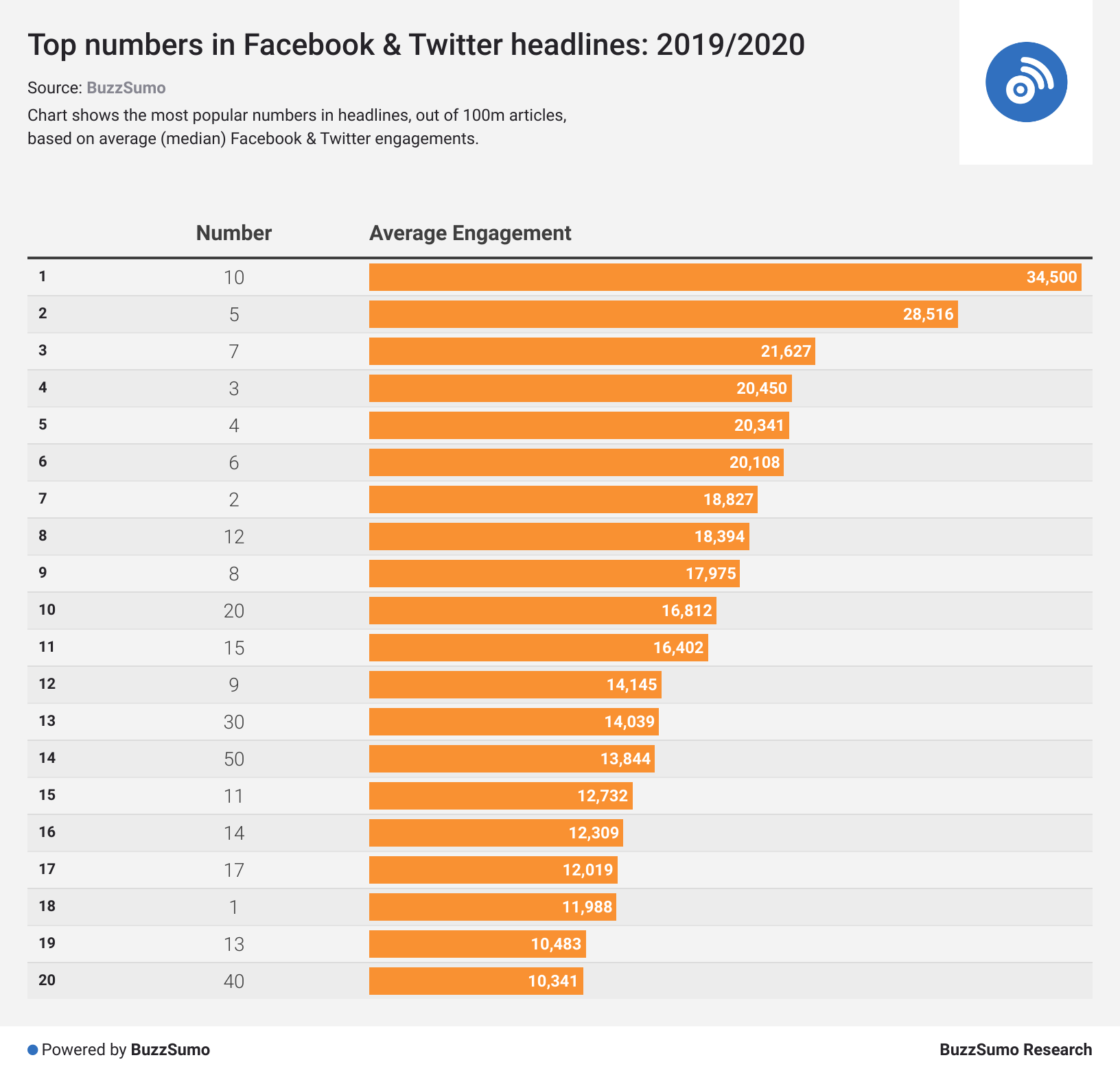 Screenshot from Buzzsumo, August 2021
Screenshot from Buzzsumo, August 20214. Punctuation?!.
One of the easiest places to start with testing is around punctuation, and yet, few focus on tests this “simple.”
An analysis of 612 top-performing branded paid ads revealed that 48% of ads used exclamation points while just 11% used a dollar sign and even fewer used a question mark.
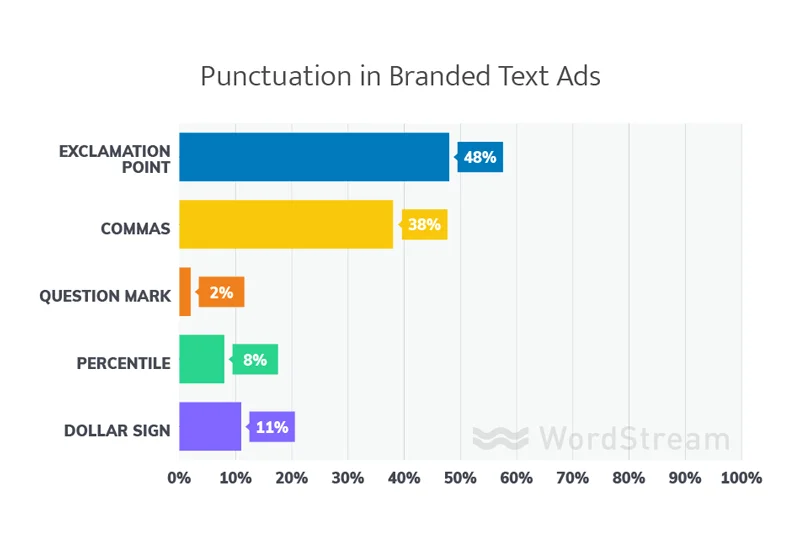 Screenshot from WordStream, December 2021
Screenshot from WordStream, December 2021According to that same survey, the following punctuations were most common in non-brand paid ads:
- Exclamation: 42%
- Commas: 25%
- Question Mark: 11%
- Percentile: 9%
- Dollar Sign: 8%
Based on our own testing, the use of an exclamation point makes sense:
 Screenshot by author, April 2022
Screenshot by author, April 2022That said, the opportunity to test the use of punctuation (question marks, percentages, etc.) are worth exploring and align well with the use of emotion to drive incremental performance.
5. Appeal To Emotion
Most ads are extremely similar. They’re boring. They’re all the same. See?
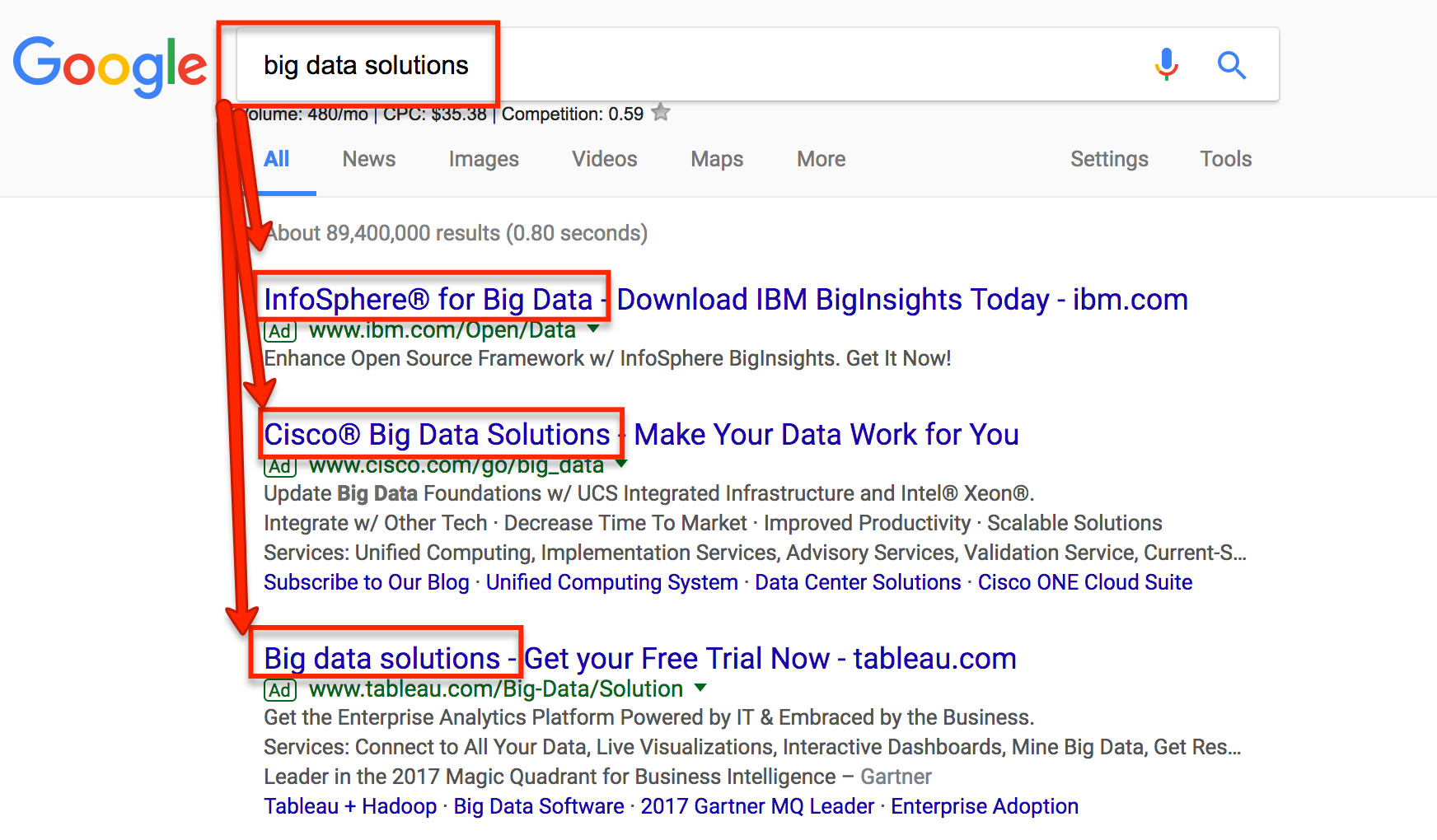 Screenshot from search for [big data solutions], Google, August 2017
Screenshot from search for [big data solutions], Google, August 2017Determine what your customer’s emotions are.
- What do they love/hate?
- What’s the biggest problem they face?
- How are you going to solve it?
Worst case, take a hint from headline categories that drive engagement on Twitter and Facebook.
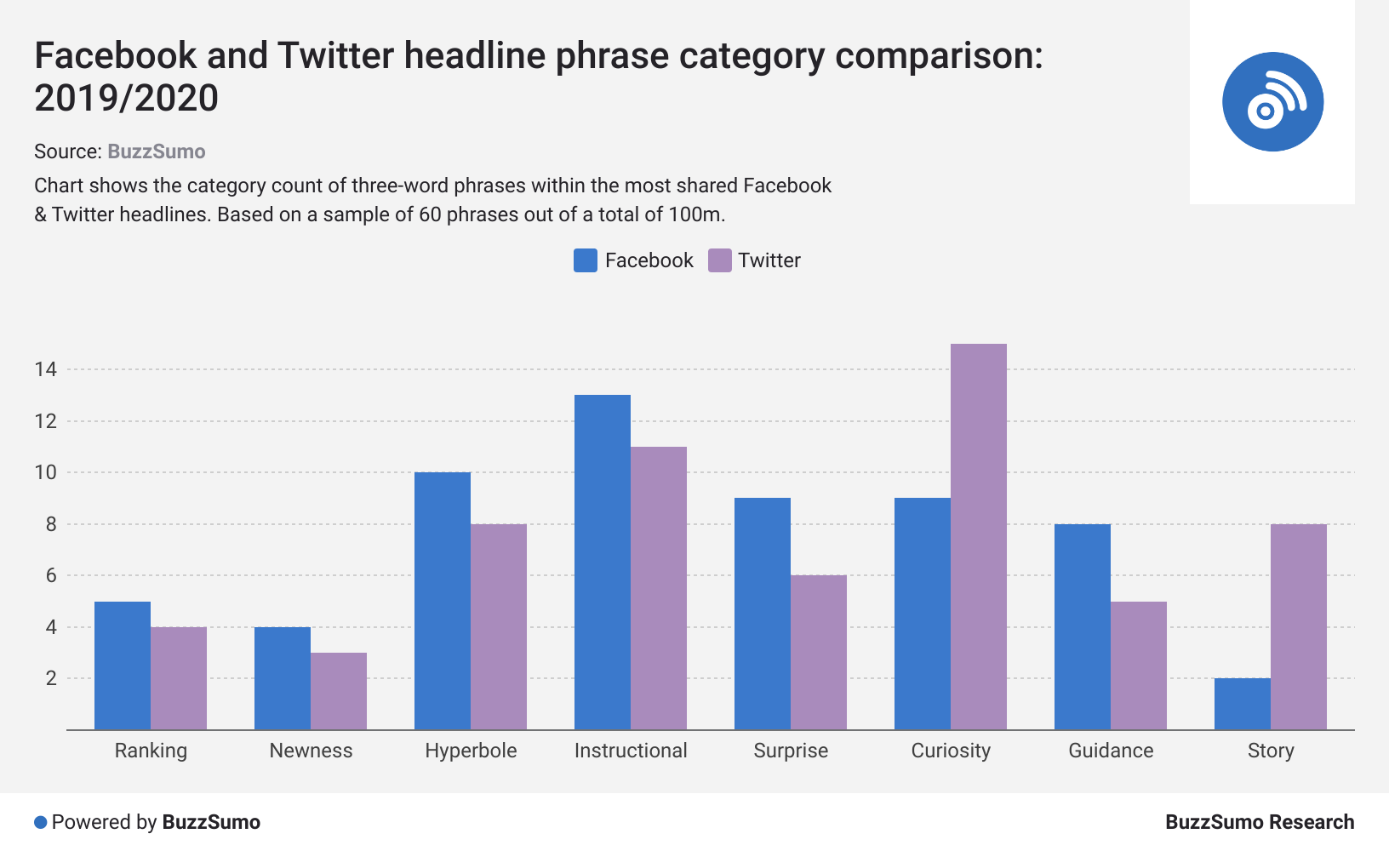
While traditionally reserved for content ideation, using a headline analyzer like this one or this one can also help with the application of emotional headlines for ad copy.
6. Test Your CTA
Let’s face it, different people have different reactions to ads.
A key ingredient in shaping people’s reactions to your ads is presentation – basically, the way you ask them to trust your brand or try your product or service.
This is where language comes in, and it’s especially important when writing your CTAs.
As trivial as it may sound, the first word of your CTA has the potential to create a positive or negative impression of the ad itself.
The first word in your CTA could be the defining factor, so you need to test different first words (all of which should be verbs) in your CTA, and use the high converting copy.
For example, beginning with “Call us now,” instead of “Contact us today,” could lead to a noticeable difference in CTRs.
Likewise, “Shop now,” instead of “Order now” could lead to different levels of audience reaction.
Here’s a mashup of potential calls to action variations for you to test:
- Get
- Shop
- Buy
- Build
- Discover
- Book
- Order
- Purchase
- Get Started
- Call
- Request
- Reserve
- Make Reservation
- Join
- Try
- Take
- Download
- Sign up
- Learn
- Subscribe
- See
- Find Out
- Estimate
- Start
7. Play Around With Your Landing Pages
Naturally, landing pages are a great marketing tool, because they give your target market a chance to decide whether they should interact further with the business.
As a result, testing your landing pages is a fundamental part of doing business online.
Within Google Ads, there are a couple of landing page tests that you can easily do without making any changes to your website:
- Link directly to the most popular product in a category you’re advertising.
- Link directly to the category page.
- Try out different sorting methods on your category pages:
- Best selling first.
- Cheapest first.
- Newest first.
- Best reviewed first.
- Promotions first.
- Manual placement.
- Link to a search made for a particular brand, product or type of product.
- Link to your homepage (yes, it might work for you).
Pro Tip: Google Optimize is a godsend for this type of A/B and multi-variant testing (for both paid media and SEO).
When it comes to campaign optimization, you need to constantly be split testing like this and then analyzing your results. Otherwise, you’re doing your company – and your campaign – a huge disservice.
What’s Next?
Anyone in marketing knows that well-placed ads don’t come cheap.
Thorough ad copy testing can give you confidence in your ads and boost your chances of making a return on those that you do decide to run.
Following the steps above can help you to test your ad copy as best as possible before investing money in their placement. But what’s next?
Whether you experience success or find that you need to make further changes or improvements, ad testing should stay at the forefront of your list of priorities.
It’s important that you track your ads’ performance and analyze the data you collect.
This will help you to alter and edit ads as needed and make even more informed decisions going forward, maximizing success and profit.
Remember A.B.T: Always. Be. Testing.
More Resources:
- How & When to Use Subliminal Messages in Your Ad Copy
- How to Trigger Urgency in Your Marketing Copy
- Perfectly Optimized Content From Start To Finish
Featured Image: Minimallista/Shutterstock

![7 Ad Copy Tests To Boost PPC Performance [With Examples]](https://www.searchenginejournal.com/wp-content/uploads/2022/01/ad-copy-tests-62398a4d7d97d-sej.png)



